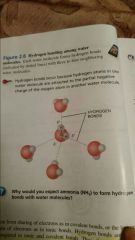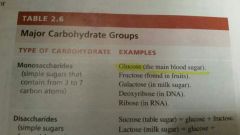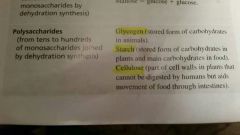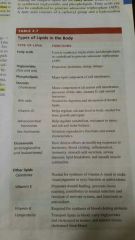![]()
![]()
![]()
Use LEFT and RIGHT arrow keys to navigate between flashcards;
Use UP and DOWN arrow keys to flip the card;
H to show hint;
A reads text to speech;
47 Cards in this Set
- Front
- Back
- 3rd side (hint)
|
Mass number |
= protons + nuetrons |
|
|
|
Radioactive isotopes; half-life |
Unstable isotopes that decay overtime to a more stable configuration; the time required for half of the radioactive isotope atoms in a sample to decay |
|
|
|
Molecule |
A compound where atoms share electrons |
|
|
|
Compound |
A substance that contains atoms of two or more different elements |
H20 is a compound, but O2 is not |
|
|
Free radicals |
Atom with an unpaired electron in its outermost shell; unstable and highly reactive; becomes stable when giving up the electron |
|
|
|
The types of chemical bonds |
Ionic, covalent, hydrogen |
3 types |
|
|
Chemical bond |
The forces that hold together the atoms of a molecule or a compound |
|
|
|
Chemically stable |
The atom has a full valance shell; all atoms want to be chemically stable and have a full outer shell. |
|
|
|
Ionic bond |
Strong electrical attraction between two opposite charged ions; electrons are transferred and not shared, creating positive and negative charges on the atoms due to the uneven amount of protons and electrons. |
|
|
|
Covalent bond |
Atoms share their electrons, not gain or lose them. |
|
|
|
Nonpolar covalent bond |
Two atoms share the electrons equally; no tug of war; if they are two identical atoms of the same element, they will always have a nonpolar covalent bond. |
|
|
|
Polar covalent bond |
The sharing of electrons between two atoms is unequal because one atom is more electronegative - the power to attract electrons to itself; there is a tug of war over the electrons and the strongest one has a better lead. |
|
|
|
Electronegativity |
The power to attract electrons to itself. |
|
|
|
Hydrogen Bonds |

Forms when a hydrogen atom with a partial positive charge attracts the partial negative charge of neighboring electronegative atoms; form weak single bonds; establish important links between molecules (ex. H2O) or between different parts of a large molecule (such as proteins or nucleic acids) binding it into a specific 3-D shape. |
|
|
|
Chemical reaction |
Occurs when new bonds form or old bonds break between atoms; the interactions of valence electrons are the basis of all chemical reactions |
|
|
|
Metabolism |
Sum of all the chemical reactions in the body or a cell. |
|
|
|
Activation Energy |
The collision energy needed to break chemical bonds in the reactant molecules so a reaction can start; the initial energy investment needed to start a reaction; Then as enough energy is absorbed, the reactants' bonds become unstable and form new combinations. As new bonds form, energy is released to the surroundings. |
|
|
|
Catalysts |
Chemical compounds that speed up chemical reactions by lowering the activation energy needed for a reaction to occur; lowers the amount of energy needed to start the reaction; properly orient the colliding parts in the right spot; catalyst molecules are unchanged and can be used repeatedly to speed up more reactions. |
|
|
|
Enzymes |
The most important catalysts in the body; replace using harmful higher temperatures and concentrations for chemical reactions to occur in the body, as temp. and concentrations are originally too low in the human body for chemical reactions to occur. |
|
|
|
Anabolism; Synthesis Reactions |
When atoms or molecules combine to form new and larger molecules; usually endergonic reaction (absorbs energy) |
|
|
|
Catabolism; Decomposition reactions |
Split up larger molecules into smaller atoms, ions, or molecules; usually exergonic (releases energy) |
|
|
|
Collision influences |
Temperature and concentration of particles. The higher, the more likely a collision will occur and cause a chemical reaction |
|
|
|
Inorganic compound |
Usually lack carbon and are structurally simple; include water and electrolytes (salts, acids and bases) |
|
|
|
Organic compound |
Always contain carbon & usually hydrogen; always have covalent bond; most are large molecules, made up of long carbon atom chains; proteins, carbohydrates, lipids, nucleic acids, ATP |
|
|
|
Water |
Most important and abundant inorganic compound in living systems; medium of nearly all chemical reactions; the polarity makes an excellent solvent for other ionic or polar substances (ex: salt or sugar), gives it more cohesion (sticks together), and makes it absorb and release heat slowly. |
|
|
|
Importance of water |
Cells: Good solvent and aids in the transport of solute through the plasma membrane and inside the cell itself; Helps maintain body temperature as it absorbs and releases heat slowly; Helps to cool skin by the evaporation of sweat from the surface of the skin; it is an important reactant in digestion of food. |
|
|
|
Hydrolysis reactions |
Water participates as a reactant; Chemical reaction where water is added to a large molecule to separate it into two smaller molecules; Aids in digestion of nutrients |
|
|
|
Dehydration synthesis reaction |
Water participates as a product; two small molecules are joined to form a larger molecule releasing a water molecule; a hydrogen atom is removed from one monomer, and a hydroxyl group is removed from the other, to form a polymer and a molecule of water |
|
|
|
Water as a lubricant |
Mucus in respiratory and digestive systems; synovial fluid in joints; serous fluid in chest and abdominal cavities where internal organs touch and slide over one another. |
|
|
|
Acids |
Dissociate into H+ ions and anions |
|
|
|
Bases |
Dissociate into OH- ions and cations |
|
|
|
Salt |
Product of acid and base (neutralization reaction); dissociate into anions and cations, that aren't either H+ or OH-; exist as crystals in absences of water; high melting and boiling points; most important salts in the body are calcium phosphates which contribute to hardness of bones and teeth |
|
|
|
Electrolytes |
Flow of ions; Important salts in the body that carry electrical currents (in nerve or muscle tissue). |
|
|
|
Concept of pH |

pH scale runs from 0 to 14 - concentration of H+ in moles/liter; A pH of 7 is neutral and H+ and OH+ are equal; pH below 7 = acidic; pH above 7 = alkaline (basic);
ex: pH of 4 would be 0.0001 (10^-4) mol/L. It also has 10 times more H+ than pH of 5, and 100 times more than pH 6, etc. |
|
|
|
pH |
pH = log1 / [H+] = -log [H+] Reciprocal of hydrogen ion concentration. Normal arterial blood = pH 7.4 (range 7.36 - 7.44) Normal venous blood and intersitial fluid = pH about 7.35 |
|
|
|
Acidosis |
Too much of acid in body and not enough base |
|
|
|
Alkalosis |
Too much base in body and not enough acid |
|
|
|
Buffer Systems |
Help maintain almost constant pH in body; Function to convert strong acids or bases into weak acids or bases to avoid acidosis and alkalosis; body fluids vary in pH: Bile 7.6 to 8.6 Saliva 6.35 to 6.85 Gastric juice 1.2 to 3.0 |
|
|
|
Buffer |

The chemical compounds that convert strong acids or bases into weak ones; the most important extracellular buffer is carbonic acid - bicarbonate buffer system; it catches H+ ions or provides H+ ions as needed |
|
|
|
Organic compunds |
Always contain carbon and hydrogen; usually contain covalent bonds; usually large, unique molecules with complex functions; make up 40% of body mass. |
|
|
|
Macromolecules |
When small organic molecules combine into very large molecules; they are usually polymers (a large molecule formed by the covalent bonding of many identical or similar small building-block molecules called monomers). |
Macro = large |
|
|
Carbohydrates: Monosaccharides |

Called simple sugars; contain 3 to 7 carbon atoms; the monomers used to build carbohydrates; our bodies can only absorb 3 simple sugars without further digestion in our small intestine and into our blood stream - glucose (main blood sugat), fructose (fruit), galactose (milk) |
-sacch = sugar, mono- = one |
|
|
Carbohydrates |
-Diverse group of substances from C, H, and O; ratio of hydrogen to oxygen atoms is usually 2:1, like water; ratio of one carbon atom for each water molecule - main function: source of energy for ATP formation; building blocks of DNA and RNA (ribose sugars) - forms 2-3% of body weight -include sugars, glycogen, starches, and cellulose |
"Watered carbon" for its 1:1 carbon:water ratio |
|
|
Carbohydrates: Disaccharides |

Simple sugars. Consists of two monosaccharides that have combined by dehydration synthesis; Sucrose = glucose and fructose Maltose = glucose and glucose Lactose = glucose and galactose (lactose intolerance) Can be split into smaller, simpler substances by hydrolosis. |
|
|
|
Carbohydrates: Polysaccharides |

Contains 10s or 100s of monosaccharides joined together through dehydration synthesis; -In animals: glycogen is a polysaccharide chain of hundreds of glucose (sugar) molecules, which is stored in the liver and skeletal muscle. Liver hydrolyzes (breaks down) glycogen to release glucose in the blood when sugar levels are low. -in plants: starch and cellulose are large carbohydrate molecules used for energy storage... cellulose however isn't digested by humans. |
|
|
|
Lipids |

Make up 18-25% of body mass; insoluble (hydrophobic); to become more soluble in blood plasma, lipid molecules join with hydrophilic protein molecules to, resulting in lipoproteins; Lipids consist of: -Fatty acids (smallest lipids) -Triglycerides -Phospholipids -Steroids -Eicosanoids -Vitamins |
Lip- = fat |
|
|
Importance of lipids |
-Used in the structure of cell parts (membranes) -supply energy -protection and insulation -protective coating to prevent infection and excess loss or gain of water -some hormone composition
|
|

